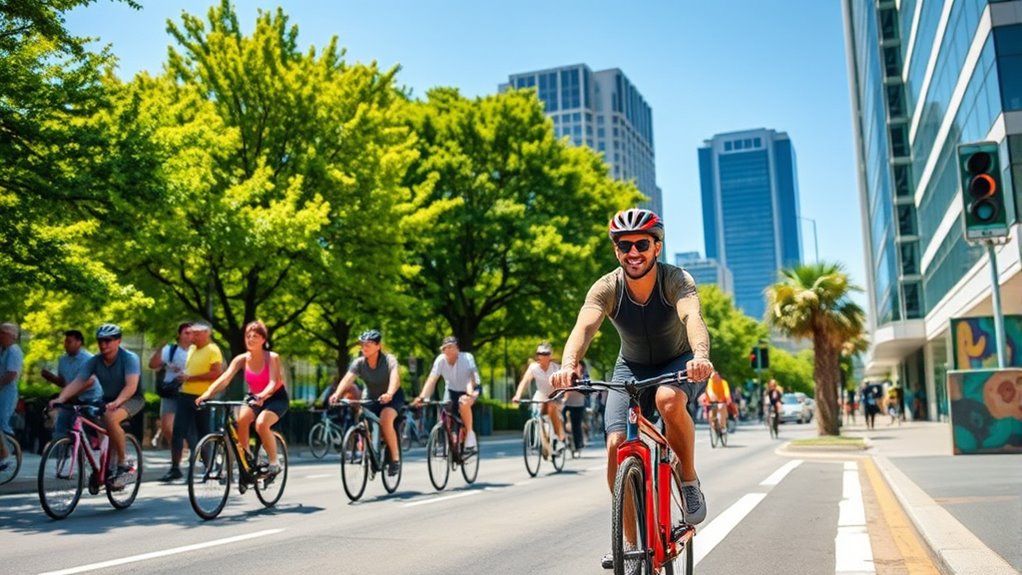Sustainable commuting options for city dwellers include public transportation, cycling, walking, carpooling, and electric vehicles. Public transit saves you money and boosts local businesses. Cycling not only improves your health but also cuts down emissions. Walking is the greenest option, enhancing community interactions. Carpooling decreases vehicles on the road and saves on fuel costs. Electric cars offer cleaner air and lower expenses. Explore more eco-friendly choices that'll transform your daily commute into a sustainable journey.
Key Takeaways
- Public transportation significantly reduces carbon emissions and saves commuters about $13,000 annually compared to driving.
- Cycling improves air quality, enhances health, and alleviates traffic congestion, making it an efficient urban commuting option.
- Walking is the most eco-friendly mode of transport, promoting social interaction and boosting property values in walkable neighborhoods.
- Carpooling and ride-sharing lower greenhouse gas emissions, reduce traffic congestion, and save money on fuel and maintenance costs.
- Electric and hybrid vehicles offer improved fuel efficiency, zero emissions, and financial incentives, contributing to cleaner urban environments.
Benefits of Public Transportation

When you choose public transportation, you're not just making an eco-friendly choice; you're also reaping numerous benefits that impact your wallet, community, and the environment.
For starters, public transit can save you around $13,000 annually compared to driving. Investing in public transportation creates jobs, too—about 50,000 for every $1 billion spent. This investment can lead to significant community engagement and improved social cohesion, similar to how public transit boosts business sales in nearby areas. Additionally, the mental and emotional benefits of reduced traffic congestion can enhance overall well-being in urban settings.
Your local economy thrives as public transit boosts business sales significantly; a $10 million investment can generate a $30 million gain for nearby businesses.
Plus, living near public transportation can increase your home's value by up to 24%. Additionally, sustainable practices in public transport can further enhance environmental benefits, reducing overall carbon emissions.
The Advantages of Cycling for Urban Commuters

Cycling offers urban commuters a practical and environmentally friendly alternative to driving, making it an appealing choice for those looking to enhance their daily travel.
By opting to cycle, you help reduce carbon emissions and improve air quality, creating a cleaner urban environment. Regular cycling also boosts your health, lowering the risk of cardiovascular disease and improving mental well-being, while also promoting regular maintenance of your body through physical activity. Additionally, engaging in continuous learning about cycling techniques and safety can further enhance your commuting experience. Cycling provides an opportunity for physical activity that is essential for maintaining a healthy lifestyle.
Cycling not only lowers carbon emissions but also enhances your health and well-being, fostering a cleaner urban environment.
Economically, you'll save money on fuel, parking, and vehicle maintenance, making it a cost-effective option. Plus, cycling eases traffic congestion, allowing for quicker commutes and smoother travel in busy areas.
With cities increasingly investing in cycling infrastructure, you'll enjoy safer roads and better overall urban planning, making cycling not just a choice, but a lifestyle advantage. Additionally, hybrid bikes provide versatility on various terrains, enhancing your commuting experience.
Walking: The Most Eco-Friendly Option

While cycling is a fantastic option for urban commuters, walking stands out as the most eco-friendly mode of transportation available.
Walking produces no emissions, helping to improve air quality in our cities. By choosing to walk instead of driving for short trips, you can significantly cut CO2 emissions and contribute to a healthier environment. Moreover, predictive modeling can identify the most effective routes for pedestrians, ensuring safer and more efficient walking paths. Furthermore, adopting a data-driven decision-making approach can help city planners create more walkable environments that cater to community needs. Additionally, fostering a sense of home and heritage through walkable neighborhoods can enhance the overall well-being of seniors and the community.
Moreover, walkable communities promote social interactions, boost property values, and create vibrant neighborhoods. Regular walking also enhances your cardiovascular health and can lower healthcare costs over time. Additionally, investing in pedestrian-friendly infrastructure supports eco-friendly practices that reduce traffic congestion and bolster local economies.
Carpooling and Ride-Sharing: Sharing the Road

Carpooling and ride-sharing offer a practical solution to the challenges of urban commuting, allowing you to share the road with others while reducing your environmental impact. By decreasing the number of vehicles on the road, you help lower greenhouse gas emissions and improve air quality. Plus, it cuts traffic congestion during peak hours, making your commute smoother. Additionally, utilizing freelance sites can provide additional income opportunities that align with a flexible commuting schedule. These options can also serve as a means of family caregiver contracts, helping to clarify roles and responsibilities if you are coordinating rides for family members.
You'll also save money on fuel and maintenance costs, while reducing the need for extensive parking infrastructure. Furthermore, many of these initiatives align with the benefits of hydrogen fuel cells, which generate zero harmful emissions and contribute to cleaner urban environments. Technology plays a key role here, with apps matching riders based on location and schedules. Additionally, participating in budgeting strategies can help you manage the costs associated with commuting effectively.
The Rise of Electric and Hybrid Vehicles

As urban areas continue to grow, the rise of electric and hybrid vehicles is transforming how you commute.
These vehicles offer impressive fuel efficiency, especially in stop-and-go city traffic, improving fuel consumption by 20 to 25%. With zero emissions, electric vehicles contribute to cleaner air, while hybrids reduce emissions and enhance energy efficiency with features like regenerative braking. Additionally, the integration of renewable energy sources into the charging infrastructure further supports a transition to sustainable commuting practices. Moreover, the adoption of energy-efficient systems, such as heat pumps, can complement the use of electric vehicles by promoting overall sustainability in urban environments. Heat pumps significantly lower carbon emissions compared to fossil fuels, aligning with the goals of sustainable commuting.
You'll also enjoy financial benefits through lower fuel costs and government incentives. Compact designs make navigating narrow streets easier, and expanding charging infrastructure boosts convenience. Additionally, electric vehicles can help reduce reliance on fossil fuels, promoting a more sustainable urban environment.
Frequently Asked Questions
How Can I Integrate Multiple Commuting Options Effectively?
To integrate multiple commuting options effectively, start by mapping your route to identify key transit points.
Combine cycling or walking with public transport for shorter distances, using bike racks available on buses or trains.
Consider carpooling with coworkers or friends to reduce emissions and share costs.
Lastly, stay flexible; telecommute when possible, and utilize ride-sharing services for longer trips.
This mix keeps your commute efficient, eco-friendly, and cost-effective.
Are There Government Incentives for Sustainable Commuting Options?
Yes, there are several government incentives for sustainable commuting options.
You can benefit from commuter programs that offer pre-tax transit benefits, making public transport more affordable.
Parking cash-out programs encourage you to choose alternative transportation by providing cash for not using a parking space.
Additionally, tax incentives support employers who promote eco-friendly commuting, helping you save money while reducing your carbon footprint.
Exploring these programs can enhance your commuting experience significantly.
What Are the Best Apps for Planning My Commute?
Think of your commute as a puzzle waiting to be solved. To make it easier, you've got some great apps at your fingertips.
Citymapper's like a compass, guiding you through real-time transit options, while Google Maps offers versatile routes for driving or public transport.
Moovit uses AI to refine your journey, and Transit Apps keep you updated.
With these tools, you'll stitch together a seamless commute, no matter where you're headed.
How Do I Ensure My Bike Is Safe While Parked?
To ensure your bike's safe while parked, always use a heavy-duty lock and secure it in a well-lit, high-traffic area.
Consider registering your bike, as this can aid recovery if it's stolen.
Look for secure racks or enclosed units that protect against theft and weather.
Stay aware of community initiatives for bike safety and maintenance, and educate yourself and others on effective theft prevention strategies to keep your bike secure.
What Are the Environmental Impacts of Ride-Sharing Services?
Did you know that rideshare vehicles emit nearly 50% more greenhouse gases per passenger-mile than regular cars?
While ride-sharing may seem convenient, it contributes to increased traffic congestion and air pollution.
Electric fleets can help, but they still rely on local power sources, which can worsen air quality.
You might find yourself contributing to these issues without realizing it, so it's crucial to consider the broader environmental impacts of your transportation choices.
Conclusion
In a bustling city, weaving through the daily grind, you've got choices that can transform your commute into an eco-friendly adventure. By hopping on a bus, cycling past traffic, or sharing rides, you're not just easing your journey—you're painting a greener future. Every step, pedal, and shared seat is a brushstroke in the masterpiece of sustainable living. So, embrace these options, and watch as your small actions bloom into a vibrant change for your city.









